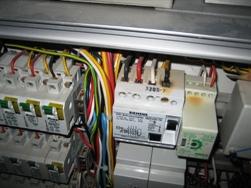Categories: Featured Articles » Electrician at home
Number of views: 688,468
Comments on the article: 28
The choice of cable cross-section for an apartment, house, cottage
 An article on how to choose the right section of a wire or cable
An article on how to choose the right section of a wire or cable
During electrical work, namely, at the stage of laying wires, cables, “Especially Advanced” customers are interested in why we are laying, for example, on sockets, cable cross-section of 2.5 mm square, when 1.5 mm square is enough, based on power consumption ... In this article we will try to deal with the cross-section of wires laid for various consumers.
So, on how correctly you select the cross-section of the laid wires, the further performance of consumers depends in many respects.
House wiring, cottage or apartment begins with an input cable. The main load that is in the house lies on this very cable. In order to find out what section the input cable is needed, we need to count all the electrical appliances that can work in the house - Washer, boiler, iron, microwave, air conditioning, etc. As a result, we find out the total power that electrical appliances consume in your home. Next, multiply this figure by a factor of 0.75. This is the very number we need.
Be sure to check out:
How many amperes are in amperes, how to convert amperes into watts and kilowatts
For a more correct calculation of power consumption, a table will help you, where the devices and the power that they consume are indicated.
Well, then, as they say, a matter of technology. To select a cable that will satisfy the requirements, there is another table that shows the cable cross-section, power and current that these cables can withstand.
This table shows the values for copper cable wires, since almost no one uses aluminum wires today when installing electrical wiring.
Cable and wire cross-section selection table
Conductor cross section, mm
Next, we need to calculate the cross-section of wires and cables for outlet groups and lighting groups. If you look at the table or calculate from simple formulas to calculate the cross-section of the wires, it will become clear that, for example, for groups of lighting, a wire with a cross section of 0.5 mm square is quite suitable, and for socket groups, a wire with a cross section of 1.5 mm square is enough.
But, as a rule, wires with a diameter of at least 1.5 mm square are used for lighting, and for outlet groups they use wires with a cross section of at least 2.5 mm square, unless, of course, power is required for devices whose total power does not go beyond the limits of which this wire is able to withstand . This is due to the fact that the wires, and no matter what metal they are made from, are subject to corrosion, various mechanical stresses both during installation and during operation.
For example, according to the table, at a voltage of 220 V, a wire with a cross section of 2.5 mm square can withstand currents up to 27 A (5.9 kW). To protect wires and consumers, in this case, an automatic machine is installed as protection, the maximum tripping current of which should be no more than 25 A.
When designing the wiring, it is necessary to take into account the length of the trunk, which will power the end user.Also, according to the table, it is possible to determine the cross section for other types of load. Also, during the design, and then the installation of wiring, do not forget about the selectivity of machines.
In any case, electricity is invisible and does not forgive mistakes and careless attitude to work. Trust the professionals!
Read about choosing a cable brand here -Which cable to choose for wiring in the apartment
In addition to current and power, designers use a number of other important parameters when choosing a cable section. Read about it here:How to choose a cable section - designer tips
Why is aluminum gradually removed from everyday life when installing electrical installations? Why is he bad and dangerous? The answer is here:Why aluminum cable cannot be used in electrical wiring
Copper and aluminum wires are not recommended. But sometimes they are connected. How do they do it?How to connect copper and aluminum wires
See also at e.imadeself.com
:
